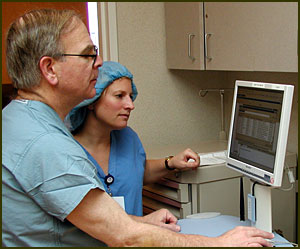 |
 |
 |

March / April 2006

Making CPOE Work
Making CPOE Work:
Redesign Workflows to Optimize Benefits


 |
|
Photo courtesy of Evanston Northwestern Healthcare.
|
By Rod Piechowski
Introducing computerized physician order entry (CPOE) to a healthcare setting is more than just a complex technological undertaking. It represents a resolve to fundamentally change the way care is delivered, affecting everyone in the organization from administrators to clinicians to patients. And that's as it should be: The purpose of CPOE is to improve care decisions, patient outcomes, patient safety, and efficiency.
Despite its promise, fewer than 5% of U.S. hospitals have implemented CPOE systems because of the high costs and complexity of implementation. But a growing body of knowledge from those that have pioneered CPOE systems can increase the chances of success for those who follow. Chief among the lessons is that organizations cannot optimize the technology's benefits without mapping, analyzing, and reengineering existing workflows.
Begin with the End in Mind
It is important to focus on and communicate the ultimate goals of better patient safety and care delivery. One guiding principle also should be to create processes that do not add to doctors' burdens. So, for example, CPOE should combine all types of orders on inpatient units (tests, medications, patient care, etc.) to avoid separate ordering processes.
There are a number of models and strategies for assisting with redesigning workflow processes and testing for quality, including Six Sigma tools and principles and the Plan, Do, Study, Act methodology. Though the specifics of these methods differ, the core ideas are similar. They call for a methodical, systematic, and cyclical approach to process redesign, stemming from an initial review of the process; consultation and building in accordance with the stakeholders; implementing the new process; and testing the new process for quality.
| |

 |
Photo courtesy of Evanston Northwestern Healthcare.
|
The workflow redesign process begins with pre-implementation planning, remains tightly integrated with system implementation activities, and continues long past implementation and going live through performance measurement and workflow optimization. Due to the enormous complexity of healthcare practices, effective workflow redesign requires consideration of how to best align the technology with:
- Reconfigured organizational structures

- Physical facility layout

- Flow of information within the organization

- Patterns of information usage

- Needs of the CPOE users
Those in charge of workflow redesign must be able to rely on the support of project leadership, and they must have the authority to make executive-level decisions to guide the redesign process
The Current State of Affairs
The first step in workflow redesign is to document current workflows. Begin by identifying any existing workflow or process descriptions. Since in actual practice the workflow could be different, enlist clinician volunteers who are willing to be shadowed to document the real processes. Do so by:
- Observing clinicians during all of their tasks, not just those where orders are written.

- Making sure to shadow at least one clinician for each role in each department affected by CPOE. That means in an emergency department (ED), for example, shadowing more than one triage nurse, ED nurse, pharmacist, ED doctor, etc.

- Shadowing different people in certain departments at various times of the day to see if the processes change after hours compared with during regular business hours. Many organizations are surprised to discover this occurs.

- Paying attention to any current paper order handoff processes that are likely to change with CPOE and being aware of where processes and departments overlap or contradict each other.
When documenting a clinical process, create a visual representation of the sequence of steps in the process. Note any peripheral or ancillary systems that might interface with the process. Include any workarounds that are used to compensate for flawed workflows. Many organizations use sticky notes to map out different nodes in a process, sticking the notes along a floor, hallway, or wall — an exercise that enables project leaders to reorder or modify the sequence of actions within
a process more easily. Then validate the workflow with the organization's CPOE champions and modify it based on their input until it matches what clinicians are actually doing.
Making Better Processes
Identify organizational guidelines and industry best practices. Compare a current process with an idealized process and analyze gaps between the two. Map the potential updated workflow, taking into account the functionality of the system.
Evaluate changes based upon the explicitly defined goals of the project. To achieve a target of, say, reducing unnecessary or redundant lab tests by 80%, project leaders must work with their vendors to evaluate how workflows can be modified to reduce duplicate orders, based on the order-checking functionality of the software. The interactions of both physicians and other clinicians must be evaluated separately, and then together, to develop the streamlined process.

 |
|
Photo courtesy of Evanston Northwestern Healthcare.
|
After completing a new, mapped workflow, it must be reviewed with clinical departments and clinicians, who should look for points of failure, potential confusion, or bottlenecks. Also validate the revised workflow with the design team and vendor to make sure the technology is being fully leveraged and to identify potential difficulties that can be avoided prior to implementation.
As new processes are finalized, make sure to keep staff informed about what is changing and why. The sooner that the staff is informed of impending changes and the longer it has to absorb them, the better the chances are of a successful implementation.
What About the Patient?
To facilitate improvement, some healthcare organizations have switched their focus from mapping specific clinical functions to the journey the patient makes through specific processes. This approach can show how individual clinicians interact to reach a goal and identify areas that need improvement from the patient's point of view.
Patient processes can be defined as a series of linked steps, tasks, or actions taken to achieve an outcome. Begin by identifying a specific process, following the same strategy used to map other processes, but starting from the perspective of the patient. For example, the process begins with a physician ordering an MRI for a patient and ends when the results are explained to the patient.
Test Before Roll-Out
Testing the revised workflow before implementation not only can save time, money, and the precious goodwill of users who would otherwise be frustrated with a flawed system, but also provides valuable knowledge for reengineering other processes (Figure 1). Start by soliciting volunteers for testing, which will minimize resistance to interruption. Begin with a single sample patient record or with one clinician in a single department or clinic, then scale up as processes are validated and refined.
Figure 1.

|
|
Gauge workflow impact both on the department directly affected and departments further downstream. Performance, quality, and other metrics are virtually meaningless without baseline data, so be sure ample data from pre-implementation assessments are available for analysis before and after the workflow change.
First, test redesigned worflows independent of the technology being implemented. These tests will be easier to conduct, and the results will be more readily apparent. Then go on to test workflows that are dependent on the new technology. For these tests, it helps to have vendor assistance in modeling the updated workflow. After completing smaller pilot tests and validating workflows that are both dependent and independent of the technology being implemented, move forward and plan a system-wide test to verify the updated workflow on a larger scale.
By breaking down the workflow redesign into a logical sequence of steps, organizations will find it much easier to leverage their new CPOE systems to reach their goals for improved patient safety, care, and efficiency. Still, as important as workflow redesign is for a successful CPOE implementation, it only takes an organization so far. Success relies on executing a whole host of other important actions, from picking the right vendor to setting specific goals.
Rod Piechowski is vice president of technology leadership for The National Alliance for Health Information Technology, managing the group's technology initiatives. Before joining the Alliance in 2003, Piechowski was the new product project manager at Heidrick & Struggles, Inc., a global executive search firm. While at H&S, he helped globalize that company's database operations. He also was publisher of Worldwide Graphics, a weekly newsletter supplying international merger and acquisition analysis to printing and publishing executives in the US, Asia and Europe. Piechowski's publishing experience includes one of the earliest conversions of a magazine group's titles to a computerized publishing cycle. He holds a bachelor of science degree in English literature from Northern Michigan University. He may be contacted at rpiechowski@nahit.org.
|
 |
 |
 |


















|
 |



